MFC: I read this code which is to draw an ellipse (not solid interior), but I cannot understand why function "pDC->Ellipse(...)" is needed twice here? (sol == 0, and do_what==DRAW_ELLIPSE)
void CMy078207017Dlg::OnLButtonUp(UINT nFlags, CPoint point)
{
flag = 0;
end = point;
assist = point;
if(p != NULL)
{
CDC* pDC = GetDC();
CPen pen;
CBrush brush;
getpen(pen, pDC, col, bol);
if(do_what >= DRAW_LINE && do_what <= DRAW_RRECT)
{
p->p[0] = start;
p->p[1] = end;
}
if(sol == 1)
{
getbrush(brush, pDC, col);
}
if(do_what == DRAW_LINE)
{
pDC->MoveTo(start);
pDC->LineTo(end);
}
else
{
if(do_what == DRAW_ELLIPSE || do_what == DRAW_CIRCLE)
{
assist = start;
if(do_what == DRAW_CIRCLE)
{
assist.y = end.y - end.x + start.x;
}
pDC->SetROP2(R2_NOT);
pDC->Ellipse(start.x, assist.y, end.x, end.y);
pDC->SetROP2(R2_COPYPEN);
if(sol == 0)
{
pDC->SelectStockObject(NULL_BRUSH);
}
pDC->Ellipse(start.x, assist.y, end.x, end.y);
end = point;
}
}
ReleaseDC(pDC);
}
CDialog::OnLButtonUp(nFlags, point);
}
If I remove the first call to pDC->Ellipse(...), the ellipse will be black solid inside. If I remove the second call to pDC->Ellipse(...), the ellipse will never be drawn but disappears when left mouse button is up.
the dialog:
when moving mouse:
 mouse moving(the pen is green)
mouse moving(the pen is green)
when mouse button pops:
 mouse button pops(the pen is green)
mouse button pops(the pen is green)
Besides, what color of CBrush is if I use "CBrush brush; pDC->Ellipse(start.x,assist.y,end.x,end.y);"
the strategy may be more clear when it comes to rectangle:
...
else if(do_what==DRAW_RECT||do_what==DRAW_RRECT){
pDC->SetROP2(R2_NOT);
if(do_what==DRAW_RECT)
{
pDC->Rectangle(start.x,start.y,end.x,end.y);
}
else if(do_what==DRAW_RRECT)
{
pDC->RoundRect(start.x,start.y,end.x,end.y,20,20);
}
pDC->SetROP2(R2_COPYPEN);
if(sol==0)
{
pDC->SelectStockObject(NULL_BRUSH);
}
if(do_what==DRAW_RECT)
{
pDC->Rectangle(start.x,start.y,point.x,point.y);
}
else if(do_what==DRAW_RRECT)
{
pDC->RoundRect(start.x,start.y,point.x,point.y,20,20);
}
end=point;
}
...